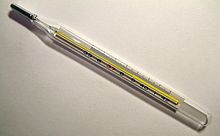Mercury thermometer
A mercury thermometer is a liquid thermometer that uses mercury as the thermometer liquid . Mercury is first mentioned in a paper by Guillaume Amontons , in which the change in the display of mercury barometers with temperature was described. The importance of this fact was recognized by the physicist Daniel Gabriel Fahrenheit in 1718 and replaced the alcohol used up until then with mercury. Others had already done this before, but since he also attached scales and his thermometers worked reliably and reproducibly thanks to calibration instructions and special manufacturing processes, he is considered the inventor of the mercury thermometer in particular, but also of the thermometer as a scientific measuring instrument in general.
Since mercury has an almost temperature-independent coefficient of thermal expansion and does not wet the glass of the thermometer tube, mercury thermometers were the most widely used thermometers until the 1970s , especially for precise measurements. Mercury thermometers can be used in the temperature range of −38 ° C (freezing point of mercury) and 350 ° C (boiling point of mercury).
If thallium is added to the mercury , the measuring range can be extended to −58 ° C.
The mercury thermometer can also be used above its boiling point if the mercury contains nitrogen under high pressure. The measuring range can thus be extended to 750 ° C.
Since mercury, as a liquid metal, is electrically conductive, it is possible to build mercury thermometers which, when a certain temperature value is reached, can carry out switching operations through a contact made in the tube, which can be used in thermostats , for example .
Since the 1970s, mercury thermometers have been increasingly replaced by other types of thermometers, especially alcohol thermometers, due to the toxicity of mercury, especially the mercury vapors that occur in the event of damage (which are contained in small spheres and are released as soon as the thermometer breaks). A clinical thermometer with mercury as an indicator contains up to 1 g of mercury. At 20 ° C room temperature, this corresponds to a sphere with a diameter of approximately 5.2 mm. Since 2009, the sale of mercury thermometers has been banned within the EU, with the exception of the scientific and medical field. Since April 10, 2014, the sale of mercury thermometers for commercial and industrial use is also prohibited.
